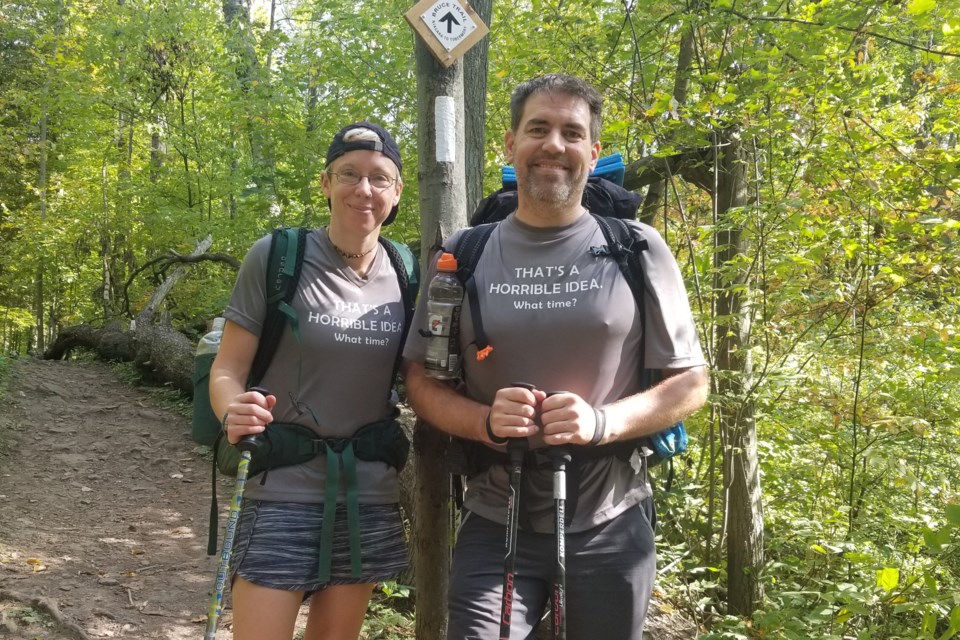For a Collingwood man, the thought of traversing the Bruce Trail was the hardest part.
That’s because Tyler Gibson lives with an acquired brain injury, the result of several concussions.
It has made an effort of routine tasks. Things like brushing his teeth and making a phone call require a lot of work, and sometimes just don’t work out.
“I try to send that message to my hands, and it gets lost…there aren’t pathways to do those,” explained Gibson. “I lost my identity. I felt useless. I felt like I was taking from society.”
But in the absence of neural pathways, he has found physical pathways to explore, and the discoveries are mental, emotional and physical.
For three weeks, he has been hiking from Niagara along the Bruce Trail with his eyes on the finish line in Tobermory. He camps nearly every night and carefully organizes his day so he consumes the proper amount of calories and reaches his destination.
Last weekend he took a few days off to rest at home in Collingwood and order all the takeout food he’s been craving. He also needed to pick up a new pair of shoes for the last portion of the hike.
“My body and spirit wants to do a marathon everyday,” he said during a phone call from the trail near Milton. “I have to pace it on what my brain is telling me I can do…part of the discovery is how to manage a brain injury.”
Gibson has been unconscious four times because of concussions. He’s been knocked out “a dozen times” for anywhere from a few seconds to a few minutes. He fell out of a moving car when he was two years old, he was sent home from the hospital the next day.
“Back then…concussions weren’t really invented,” said Gibson.
His acquired brain injury – one that occurs over time instead of during one trauma – went undiagnosed until about four years ago.
With wisdom gained, Gibson sees now he was suffering from symptoms of brain injury. Things like insomnia, anxiety, brain fatigue, and cognitive problems revealed themselves through hindsight.
“Twenty years ago, going to doctors and counsellors…I couldn’t explain it to them,” he said.
He would also try to hide, in particular, the mental health symptoms.
“That was back in the day where people didn’t speak about things like that,” he recalled.
But in recent years, he has received his diagnosis, and with it, supports from the Brain Injury Network of Toronto, occupational therapists, and a case manager.
“Suddenly I was meeting people who could finish my sentences,” he said. “I used to spend so much of my time trying to understand and I’m always on a third of a tank of gas…I was in survival mode…not knowing what to do.”
Gibson has put himself in a different sort of survival mode for his trek across the Bruce Trail. He has covered more than 500 kilometres of the 885-kilometre trail, he has missed turns, lost sleep, burned about 4,000 calories per day, blown through one pair of shoes, and skipped a few showers along the way.
“As hard as those things are, they don’t compare to those days and how hard it was living with the brain injury,” he said. “On the trail it’s so much easier. The only things to worry about are, ‘do I have enough water? I have my shelter, do I have enough food?’ It’s the only place I can find a bit of clarity. My head is never clear, it’s always foggy, but here it’s as clear as I can feel.”
The physical journey has also reached into his emotions and spirit.
“I was surprised at how rewarding it has been…I had so many bottled up emotions for so long,” he said.
Emotional support has been, in a word, “overwhelming” as Gibson discovers the meaning behind the phrase “trail magic.”
“It’s something unexpected on the trail where someone helps you for no reason but their own goodness,” he explained.
And in the age of virtual everything, the trail magic has also spread to the digital world, with Gibson receiving words of encouragement through messages and emails.
Someone riding their bike on the trail recognized Gibson from his Facebook campaign and told him how much he inspired her – her words, in turn, urged him on during a tough day.
“I’m hoping to help other people, and I’ve found it’s really helping me as well,” he said.
The hike is also serving as a fundraising and awareness campaign with all proceeds going to the Ontario Brain Injury Association. Since going public with his campaign, Gibson has observed most everyone he talks to has or knows someone who has a brain injury.
“The more we can make people aware, the better it is for everybody,” he said.
His financial goal is to raise $10,000 for the Ontario Brain Injury Association. His physical goal is Tobermory, and his mental goal is purpose.
“You’ll never know how much you’re helping other people or how much it means to other people just by sharing your story,” he said. “I’m finally doing something.”
You can support Tyler Gibson’s hike campaign via his Facebook event page online here.
